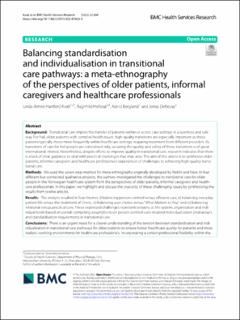| dc.description.abstract | Background Transitional care implies the transfer of patients within or across care settings in a seamless and safe way. For frail, older patients with complex health issues, high-quality transitions are especially important as these patients typically move more frequently within healthcare settings, requiring treatment from different providers. As transitions of care for frail people are considered risky, securing the quality and safety of these transitions is of great international interest. Nevertheless, despite efforts to improve quality in transitional care, research indicates that there is a lack of clear guidance to deal with practical challenges that may arise. The aim of this article is to synthesise older patients, informal caregivers and healthcare professionals’ experiences of challenges to achieving high-quality transitional care. Methods We used the seven-step method for meta-ethnography originally developed by Noblit and Hare. In four different but connected qualitative projects, the authors investigated the challenges to transitional care for older people in the Norwegian healthcare system from the perspectives of older patients, informal caregivers and healthcare professionals. In this paper, we highlight and discuss the cruciality of these challenging issues by synthesising the results from twelve articles. Results The analysis resulted in four themes: i) balancing person-centred versus efficient care, ii) balancing everyday patient life versus the treatment of illness, iii) balancing user choice versus “What Matters to You”, and iv) balancing relational versus practical care. These expressed challenges represent tensions at the system, organisation and individual levels based on partial competing assumptions on person-centred-care-inspired individualisation endeavours and standardisation requirements in transitional care. Conclusions There is an urgent need for a clearer understanding of the tension between standardisation and individualisation in transitional care pathways for older patients to ensure better healthcare quality for patients and more realistic working environments for healthcare professionals. Incorporating a certain professional flexibility within the wider boundary of standardisation may give healthcare professionals room for negotiation to meet patients’ individual needs, while at the same time ensuring patient flow, equity and evidence-based practice. | en_US |

